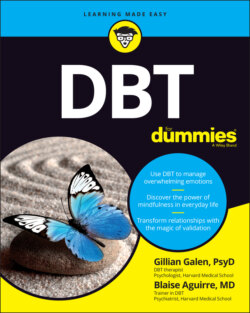Читать книгу DBT For Dummies - Gillian Galen - Страница 51
Coming to an agreement
ОглавлениеIn close relationships, feeling misunderstood or angry can be very painful. So, how do you move forward when this happens with your therapist or someone you care for? One of the biggest barriers to coming to an agreement is that you’re unable to see another perspective, or you feel that if you change your position, you’re giving up, giving in, or letting the other person win. Here are some useful questions to ask yourself in order to help you come to an agreement when you’re stuck:
Are you zooming out? As you try to come to an agreement, it can be helpful to zoom out. Think about the other person’s perspective. Does your therapist care for you? Is she trying to help you meet your goals? Could she have made a mistake? Is there wisdom in what she is saying? This technique can be very effective to use with other important people in your life when you feel misunderstood or are having difficulty seeing their point of view.
Are you being effective? It can be a helpful reminder to ask yourself whether you’re being effective. Is the perspective or the point you’re making helping you get what you need? Are you delivering it in a skillful way that your therapist or the other person can hear? Are you maintaining your integrity as you make your point?
Are you acting from a wise mind? As we discuss in the earlier section “Questioning Your First Reaction,” sometimes when you struggle to hold multiple perspectives, it’s because you’re acting from an emotion mind. Can you take a few breaths and connect to your wise mind? Your wise mind is the state of mind in which you have access to both what you feel about something and what you know or understand about something (see Chapter 9).
Are you thinking the best of the other person? While you may be feeling strong emotions, this will help you refrain from forming negative judgments about the other person. Judgmental thinking tends to drive up already intense emotions.
People disagree with one another. It’s okay to skillfully disagree, and to see the wisdom in why the other person feels that way and then simply let it be. It is “agreeing to disagree,” which isn’t uncommon. You may also agree that one or the other person is correct. This can happen when you have both been able to be curious and open to the other person’s perspective or information. A third option could be that you come up with a new perspective that somehow synthesizes each of your perspectives. What you’ll notice is that throughout the process, you’re continually looking to open your mind to see ideas or perspectives you may have missed.
